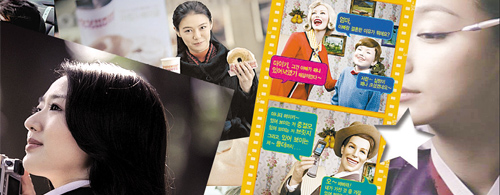Unremarkable faces new trend in ads

Products endorsed by ordinary people: From left, commercials for Hanwha apartments, Dunkin’ Donuts, LG Telecom and Hyundai Card.
It isn’t different from other commercials, until you find out that this model is not an entertainment star, but an ordinary career woman who works for a graphic design company. Kim Jung-eun, 29, was selected to promote Hanwha from among 750 candidates who participated in a modeling contest this March.
Why would any big company choose an ordinary person to promote their apartment when Kim Hyun-joo, a big star, has been their official until now?
Shin Wan-chol, an executive at Hanwha Engineering and Construction, offered an answer.
“Ordinary models bring more familiarity and intimacy to consumers than big stars,” Shin said.
This is not the first commercial not to use top stars as promoters. Daelim Industrial Company also chose an unknown model in its commercial instead of Chae Si-ra, a well-known female actress. The commercial for Daedong Company’s Dasoop apartments is promoted by an animal character, a beaver.
Have top stars in Korea lost their power? Of course, this isn’t true. However, the culture of advertising is changing. Commercials are now based more on the products than the stars.
Lee Jung-eun, the assistant director of Cheil Communications, a leading advertising agency in Korea said, “Most top female stars have been featured in apartment commercials. There is no originality that way; we need to differentiate our strategies and one way is to select unknown and mysterious models to promote our products.”
The mobile-communications industry is no exception. Nowadays, it is rare to find top stars representing mobile companies. A commercial for KT WiBro (a wireless broadband Internet technology) uses daily objects and ordinary people to emphasize its edge in capacity.
Park Hye-kyung, the designing director of KT said, “Normally, the companies in the IT industry would use big models to promote their new products.
Today, however, the younger generation seeks fresher ideas in commercials. This is why we have to come up with other ideas for promotion than just using stars.”
The KTF commercial that introduced consumers to video telephones and a global roaming system has launched 10 ads simultaneously.
Of the 10, only one is promoted by a well-known video artist, the rest are by unknowns.
LG Telecom has also changed its advertising strategy by using characters from “The Fuccons,” a Japanese animation, as its symbol. In the past, LG had top actors like Ju Jin-mo and Han Seok-gyu represent it.
Megapass, which had Hyun Bin and Eric as their promoters, has changed its marketing strategy by having “Mega Cat” as its new model.
Ahn Sung-ki and Lee Hyun-mi, both established actors, have been promoting the Prima product of Dong Suh Food Company for 20 years; however, they have been replaced by other young stars to foster an image that appeals to today’s younger generation.
Maxim’s Latte Ditto also has a unique commercial made up of anonymous models.
Dunkin’ Donuts, which had engaged Lee Byung-hun, now has foreign models that humorously promote their products.
The story is no different for commercials of major card companies, which usually feature big stars like Bae Yong-jun, Lee Young-ae, Jang Dong-gun and Lee Na-young.
The commercial for Hyundai Card, known for its popular CM song, “My Father Said,” has promoted a new series of commercials starring foreign models in “Adam and Eve” and “Lego Block.”
In terms of makeup commercials, it is hard to find a typical female model.
Instead, products are being emphasized.
The term “creative vampire” is spreading through the advertising industry.
It connotes that stars are like vampires who absorb all the attention and that in the end, consumers tend to forget the actual product or the brand that is being promoted.
Lee Sang-gyu, the manager of an advertising agency called TBWA said, “Korea and Japan are the only countries which depend on big models for promoting products. And since there are only a few, they tend to overlap in many different commercials.”
Recently, online stories have been running on the Internet: “Lee Young-ae’s day” and “Daniel Henney’s day.”
They criticize the dull and repetitive commercials in today’s society.
An official from an advertising company observed that Korea does not have many models to star in big commercials, especially in a society where scandals often destroy brand images.
The current UCC (user created content) boom is also affecting the advertising industry by changing the perspective of consumers, who prefer unique commercials.
The Vita 500 commercial that Rain and Lee Hyo-ri starred in resembled UCC made by teenagers.
Kim Hong-tak, an advertising critic and the director of Cheil Communications said, “In Western society, companies select big models after they have brainstormed other ideas. In Korea, it’s the other way around.”
He added, “The present flow of the advertising industry is absolutely natural.
In such a culture, it is more likely that “well-made” and “balanced” commercials will appear in the future.”
By Jung Hyun-mok JoongAng Ilbo [estyle@joongang.co.kr]










with the Korea JoongAng Daily
To write comments, please log in to one of the accounts.
Standards Board Policy (0/250자)